This episode of The Monochrome Chronicles goes back in time to 20 years ago – 2001-2002 to be precise, and the terrorist attack on the World Trade Center in New York. I lived in NYC at that time so the events were very personal to me. These events are etched clearly in my memory: huddling together with colleagues in a small office with a south-looking window where we could see the smoke from the Trade Center site and listen to the radio reports; walking home in the late afternoon down a 6th Avenue that was totally devoid of traffic; sitting in my darkened apartment that evening, listening to the news on the radio and trying to come to grips with the events of the day.
All these memories are still vivid in my mind. My photography series, however, covered the period of recovery after the attack. After a few days I began carrying my little point-and-shoot camera every day, with the intention of doing so every day for a year. The series progressed on its own time and its own direction. This was just something I had to do.
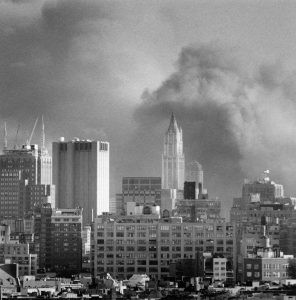
Many images have been published about the 9/11 terrorist attack in NYC. This image is my own personal, unique record of the day. It was in the late afternoon, the twin towers had collapsed during the morning, but in the afternoon, I heard on the radio that one of the smaller nearby buildings had collapsed and I caught this scene on film from my window. For several days after 9/11, I did not touch a camera. Then I started shooting again. I carried my camera every day for a year or more because I realized the value of each day.
In the days immediately after the attacks, my life seemed unreal, for I lived in the “freeze zone” below 14th Street, the area closed to all traffic except emergency and recovery vehicles. The neighborhood seemed so strange with no traffic, and I felt guilty for enjoying the quiet that descended on the streets. For weeks, the photographs of the missing, posted on the walls around the neighborhood, haunted me.
Every night, I sat in my nearly dark apartment, listening to the BBC news on the radio – I was cut off from most news sources, because without cable or internet, I lost most of the broadcast media when the WTC antenna collapsed. I had only my imagination to fuel my thoughts. I tried to make some sense of this new – and now very real – horror.
A turning point occurred one winter evening in Lincoln Center. Finally I decided it was OK to take some time for enjoyment, some escape from 9/11. It was a beautiful night, thankfully a mild winter, and I sat by the Henry Moore reflecting pool. I discovered that it was alright to enjoy music, to see beauty, to escape, even if for only a few hours at the Metropolitan Opera. The next day I might have to face the new reality of terrorism again, but for that night anyway, I was safe in the culture that could produce a thing of beauty such as a 100-year-old opera brought to life again on a Lincoln Center stage.
I carried my camera every day for the following year. These are some of the images which express the mood of the city during that time, as perceived through my viewfinder.
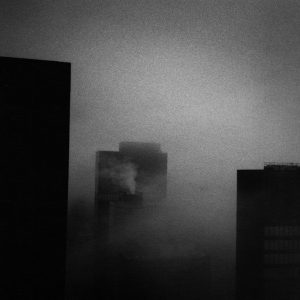
My view from the 46th floor of an office building in midtown East where I worked. The mood reflects the general sense of foreboding in the city.
The air space was closed to air traffic. Before that time, the sound of planes overhead was just a part of daily life, unnoticed, part of the woodwork. The silence during the closure of the air space was unsettling, especially at first.
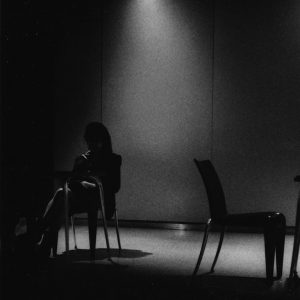
The Citicorp building was near the office where I worked and sometimes I ate lunch in the atrium. This woman captured my attention; I saw her occasionally.
She seemed like a relic left over from the 1940’s. Her face had aged but everything else about her seemed to have stopped years ago.
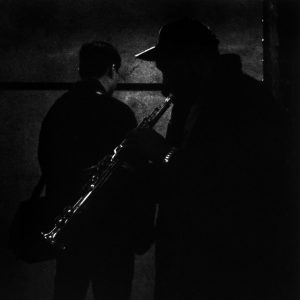
A solo musician on the subway platform. I don’t remember what kind of music he was playing, but it is easy to imagine it was the blues. And why did the man in the background turn his back, and hang his head?
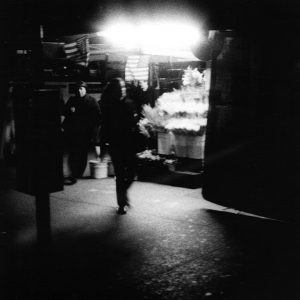
Eighth Avenue and 14th Street, from the bus window on the way home from work. The restricted zone during the crisis period started just across the street from here.
The building where I lived was inside the restricted zone so I had to show my ID at a checkpoint on my way home.
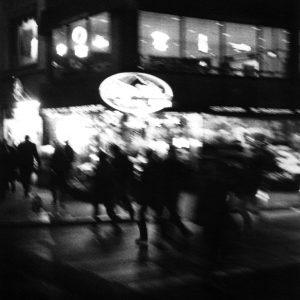
This deli was on Third Avenue near the office where I worked. Taken from a bus window. This could be an abstract image of the general feeling of unease in the city.

Sunday afternoon, West Village. Shooting from the hip while riding on a bus is more difficult than it is while riding a subway.
This woman was sitting across the aisle from me. The tilt of her head, her jutting chin and her face in shadow under the wide brim of her hat symbolize the wariness that we New Yorkers experienced during this period.
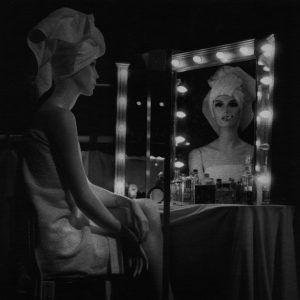
The image conveys a hint of black humor. Yes, the terrorist attack cast a shroud over the city but scenes like this were reminders that all was not lost. I can imagine this veteran of the stage and screen saying, “…but I’m still here!”
Before that time, I had been pursuing a series of photographs about riders on the subway, so continuing with the series was just part of my daily routine. The tone, the atmosphere of the images was much darker, more severe compared with the earlier images in the series.

This is part subway series and part after 9/11 series. It fits in so well with the rest of the “After 9/11” series that I feel justified in including it here.

Was she really apprehensive, or is that my projection onto the image? Maybe she was just pensive.
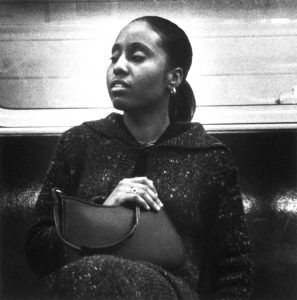
I could echo the same comments for this image as for the previous one. Obviously, anxiety and wariness when riding the NYC subway were common feelings.
What was she looking at? What was she thinking? On the contact sheet she seemed to be alone.
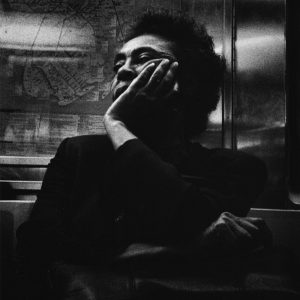
Another pre-9/11 image that appears in the series “After 9/11.” On the contact sheet, other people were sitting next to her so maybe she was reacting to something they were saying or doing.
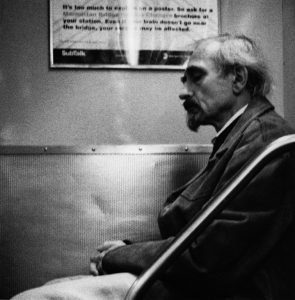
Something about this man, his posture, his face, his being alone, seems to reflect what many people were feeling about this time.
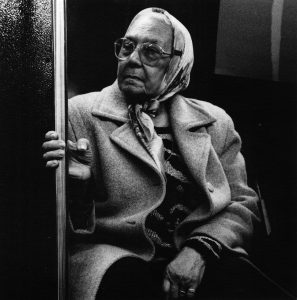
Maybe black women were always wary about riding a bus at night. To me, she seemed especially anxious.

Maybe she was just tired and going home after a long day at work. Her gesture, however, portrayed the mood of the entire city.
Now, 20 years later, images like this bring back to me some of the emotions of those days. Each year now, when I read about the ceremonial reading of the names at ground zero on the anniversary day, my first thought is that it was so long ago. Seeing these images again, well, it doesn’t seem so long ago.
Allow me to interject here to add a few observations from my personal point of view. Obviously, most if not all the images in this series derive from my experience of street photography, though my objective was different. In essence, this is my own personal journey through the course of the year after 9/11. I make no attribution about the inner thoughts and feelings of my subjects; I can project my own point of view onto the images. That is my prerogative as a photographer.

This was a grass-roots memorial for the victims, just across the street from St. Luke’s hospital, one of the emergency centers after the collapse of the twin towers. Each tile on the fence memorialized a specific victim of the terrorist attacks.
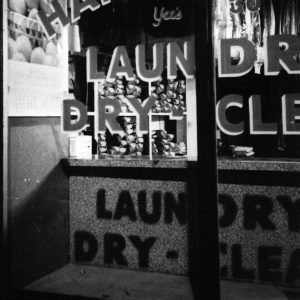
This was a laundry in the West Village. The image spoke to me and I snapped it. The relevance to my theme “After 9/11” maybe be unclear.
Tasks such as laundry and dry cleaning were part of everyday life, although this scene was at night and the shop was empty of people, imparting a lonely feeling. The process of recovery from such a horrific experience as the terrorist attack was akin to the stages of grief: denial, anger, bargaining, depression and acceptance. To me, this image reflects the idea that life must go on.
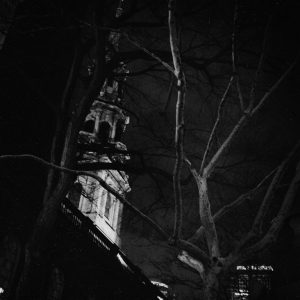
I refused to go to ground zero for nearly a year after the event. Cannot remember what stimulated me to go when I did.
The night sky was hazy. I wondered whether the spirits of the dead were still circling the site. Normally I am not inclined to such metaphysical thoughts, but the mood of the city, and especially at ground zero, changed some of my perceptions.
Most of the images in this series are quite dark, both photographically and conceptually. That is to be expected considering the theme. Gradually over the course of the year, the pall that had hovered over the city began to abate. The freeze zone within which I lived ended. The air space opened again. Slowly the posters seeking information about missing victims disappeared. The slow process of recovery could begin.
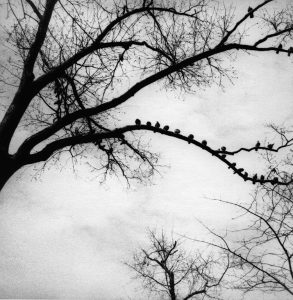
Spring finally arrived, the trees began to bud, and the birds came back. Maybe life could return to normal.

Later in the spring, obviously. These three were walking past the Tiles for America memorial, but were they aware of it?
The 9/11 terrorist attack had become part of the New Yorkers’ zeitgeist but gradually everyday life began to return.
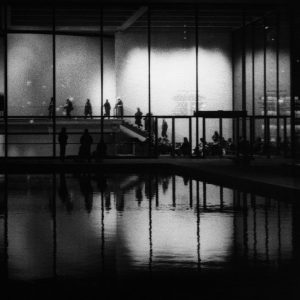
Immediately after 9/11, Broadway theaters, concert halls, the opera house and other such venues went dark. Gradually, they opened up again.
I didn’t go to any concerts or shows for a long time after 9/11. Somehow it seemed it would be disrespectful to enjoy myself. Finally, I went to Lincoln Center. I decided it was OK. Life could go on.
The theme of this episode of The Monochrome Chronicles is one of the darkest series of photographs from my time in New York. Trauma, whether it be from natural disaster or from human-source disaster, at times is unavoidable. In hindsight I now see two ways in which my nascent experience in black-and-white photography altered my response to the 9/11 attack on the World Trade Center.
One way is simply that I grabbed my camera and started shooting (albeit after a few days pause). Prior to that time, usually I would take up my camera when I had a specific objective in mind. That is, the idea for taking photographs cam first and then I’d grab my camera. For the “After 9/11” series the sequence was reversed. I took up my camera because I needed to express myself. The subjects came later, when I was on the streets or as I went about my daily life. My camera had become part of my armamentarium for expression. This was a subliminal reaction and I never questioned it.
The second way, and a much more far ranging influence, was that I began to carry my camera every day. I had learned to value each day on its own. Photography became my visual diary. Initially my intention was to carry my camera every day for one year. It turned into a life-long practice. For 20 years since then, I’ve carried my camera every day. Some days I use it, and other days not. Someone once remarked, “You never stop looking, do you?” My camera is my constant companion.